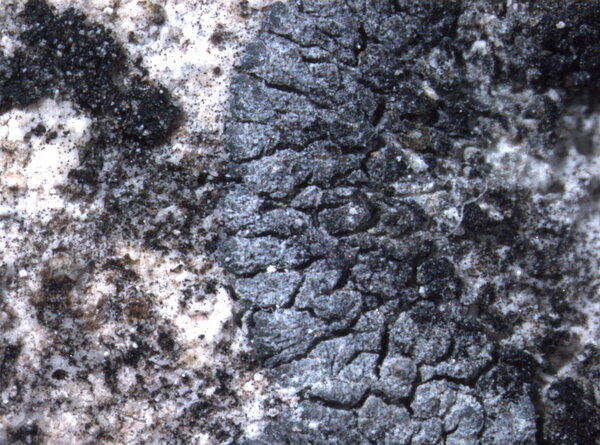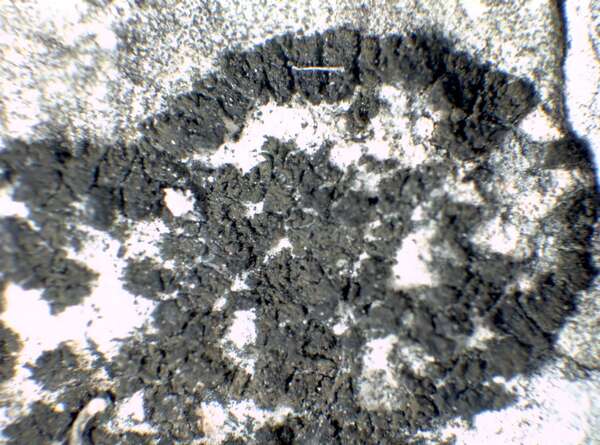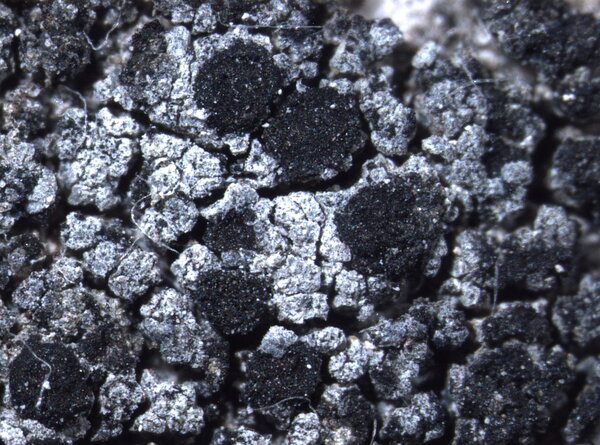Placynthium subradiatum (Nyl.) Arnold
Flora, 67: 240, 1884. Basionym: Pannaria subradiata Nyl. - Act. Soc. Linn. Bordeaux, 21: 314, 1856.
Synonyms: Lecothecium controversum Anzi; Lecothecium radiosum Anzi; Lecothecium subradiatum (Nyl.) Dalla Torre & Sarnth.; Placynthium radiosum (Anzi) Jatta; Pterygium petersii Nyl.; Pterygium subradiatum (Nyl.) Nyl.; Wilmsia radiosa (Anzi) Körb.
Distribution: N - VG, Frl, Ven (Thor & Nascimbene 2007, Nascimbene 2008c), TAA (Nascimbene 2008b, Nascimbene & al. 2022), Lomb, Emil (Fariselli & al. 2020), Lig (Czeika & Czeika 2007). C - Marc (Nimis & Tretiach 1999), Mol (Nimis & Tretiach 1999, Caporale & al. 2008), Sar. S - Camp (Nimis & Tretiach 2004, Garofalo & al. 2010), Bas (CLU 10036), Cal (Puntillo 1996), Si (Nimis & al. 1994).
Description: Thallus crustose-placodioid, olive brown to blackish grey, epruinose or faintly pruinose, forming orbicular to incomplete, 15(-20) mm wide rosettes, usually without a distinct prothallus, the central parts at first granulose-areolate, but soon dying off (sometimes regenerating with small warts or lobes), leaving narrow arcs of lobes; marginal lobes radiating, firmly adhering to the rock, usually strongly convex (subterete), 0.5-1.5 mm long, 0.03-0.25 mm wide, up to 0.15 mm thick, simple or branched, separate or more rarely contiguous. Thallus paraplectenchymatous throughout, the basal parts often brown-violet, with elongated hyphae and pale rhizohyphae more aboundant in the apical part of lobes. Apothecia rare, biatorine, black, up to 0.5 mm across, immersed to sessile, with a distinct proper margin when young. Epithecium blue-green; hymenium colourless, I+ blue; paraphyses distinctly septate, sparingly branched; hypothecium pale brown. Asci 8-spored, apically thickened, with an amyloid cap. Ascospores 1-septate, hyaline, ellipsoid, (7.5-)10-13(-15) x (3-)4-6(-8) μm. Pycnidia to 125 μm in diam., the wall colourless in basal parts, blue-black near the ostiole. Conidia bacilliform, (3.5-)5-6(-7) x c. 1 μm. Photobiont cyanobacterial, Scytonema-like. Spot tests: all negative. Chemistry: without lichen substances.Note: on vertical, sun-exposed seepage tracks of calcareous rocks, in the Mediterranean belt mostly on north-exposed faces, and also occurring in the mountains.
Growth form: Crustose
Substrata: rocks
Photobiont: cyanobacteria, filamentous (e.g. Nostoc, Scytonema)
Reproductive strategy: mainly asexual, by thallus fragmentation
On otherwise dry surfaces with short periods of water seepage after rain
Commonnes-rarity: (info)
Alpine belt: extremely rare
Subalpine belt: very rare
Oromediterranean belt: very rare
Montane belt: rare
Submediterranean belt: rather common
Padanian area: absent
Humid submediterranean belt: rather common
Humid mediterranean belt: rare
Dry mediterranean belt: very rare

Predictive model
Herbarium samples
Growth form: Crustose
Substrata: rocks
Photobiont: cyanobacteria, filamentous (e.g. Nostoc, Scytonema)
Reproductive strategy: mainly asexual, by thallus fragmentation
On otherwise dry surfaces with short periods of water seepage after rain
Commonnes-rarity: (info)
Alpine belt: extremely rare
Subalpine belt: very rare
Oromediterranean belt: very rare
Montane belt: rare
Submediterranean belt: rather common
Padanian area: absent
Humid submediterranean belt: rather common
Humid mediterranean belt: rare
Dry mediterranean belt: very rare

Predictive model
| Herbarium samples |
 INDEX FUNGORUM
INDEX FUNGORUM
 GBIF
GBIF
 DOLICHENS
DOLICHENS








